Location
SMU Location
2007/08/24 07:45:22 40.5500 123.033 10.0 3.70
SLU Location - Preferred
The SMU location could not fit the P-wave first motion on the Z and R components at station YLING. Interestingly the strongest arrival is the Transverse componet. In addition the waveform inversion required a set of positive time shifts. The preferred solution is from elocate and is given in detail in elocate.txt has an origin time about 2 seconds later than the SMU solution. Perhaps this is because of the use of the sharp S-wave arrivals.
As you can see from the plots YLING is not fit well - the solution at a close station depends upon azimuth very strongly. Fortunately the distance weighting used downweights YLING so that it does not affect the solution. The solution without YLING is
WVFGRD96 8.0 275 70 -25 3.81 0.7907
The SLU location is as follows:
2007/08/24 07:45:24 40.5300 123.064 18.0 3.70
Arrival Times (from USGS)
Arrival time list
Felt Map
USGS Felt map for this earthquake
USGS Felt reports page for
Focal Mechanism
USGS/SLU Moment Tensor Solution
ENS 2007/08/24 07:45:24:2 40.53 123.06 18.0 3.7
Stations used:
XG.HGOU XG.HQI XG.LJIA XG.MJD XG.WTANG XG.XDIAN XG.YLING
Filtering commands used:
hp c 0.05 n 3
lp c 0.50 n 3
Best Fitting Double Couple
Mo = 5.89e+21 dyne-cm
Mw = 3.78
Z = 8 km
Plane Strike Dip Rake
NP1 275 70 -25
NP2 14 67 -158
Principal Axes:
Axis Value Plunge Azimuth
T 5.89e+21 2 325
N 0.00e+00 58 59
P -5.89e+21 32 234
Moment Tensor: (dyne-cm)
Component Value
Mxx 2.46e+21
Mxy -4.80e+21
Mxz 1.74e+21
Myy -8.59e+20
Myz 1.98e+21
Mzz -1.60e+21
############--
T ###############-----
## ################-------
######################--------
########################----------
#########################-----------
##########################------------
###########################-------------
#######-----------------###-------------
##--------------------------#####---------
---------------------------###########----
---------------------------##############-
--------------------------################
-------------------------###############
------- --------------################
------ P -------------################
----- -------------###############
-------------------###############
----------------##############
-------------###############
---------#############
---###########
Global CMT Convention Moment Tensor:
R T P
-1.60e+21 1.74e+21 -1.98e+21
1.74e+21 2.46e+21 4.80e+21
-1.98e+21 4.80e+21 -8.59e+20
Details of the solution is found at
http://www.eas.slu.edu/Earthquake_Center/MECH.NA/20070824074524/index.html
|
Preferred Solution
The preferred solution from an analysis of the surface-wave spectral amplitude radiation pattern, waveform inversion and first motion observations is
STK = 275
DIP = 70
RAKE = -25
MW = 3.78
HS = 8.0
The waveform inversion is preferred.
Moment Tensor Comparison
The following compares this source inversion to others
| SLU |
SLU |
USGS/SLU Moment Tensor Solution
ENS 2007/08/24 07:45:24:2 40.53 123.06 18.0 3.7
Stations used:
XG.HGOU XG.HQI XG.LJIA XG.MJD XG.WTANG XG.XDIAN XG.YLING
Filtering commands used:
hp c 0.05 n 3
lp c 0.50 n 3
Best Fitting Double Couple
Mo = 5.89e+21 dyne-cm
Mw = 3.78
Z = 8 km
Plane Strike Dip Rake
NP1 275 70 -25
NP2 14 67 -158
Principal Axes:
Axis Value Plunge Azimuth
T 5.89e+21 2 325
N 0.00e+00 58 59
P -5.89e+21 32 234
Moment Tensor: (dyne-cm)
Component Value
Mxx 2.46e+21
Mxy -4.80e+21
Mxz 1.74e+21
Myy -8.59e+20
Myz 1.98e+21
Mzz -1.60e+21
############--
T ###############-----
## ################-------
######################--------
########################----------
#########################-----------
##########################------------
###########################-------------
#######-----------------###-------------
##--------------------------#####---------
---------------------------###########----
---------------------------##############-
--------------------------################
-------------------------###############
------- --------------################
------ P -------------################
----- -------------###############
-------------------###############
----------------##############
-------------###############
---------#############
---###########
Global CMT Convention Moment Tensor:
R T P
-1.60e+21 1.74e+21 -1.98e+21
1.74e+21 2.46e+21 4.80e+21
-1.98e+21 4.80e+21 -8.59e+20
Details of the solution is found at
http://www.eas.slu.edu/Earthquake_Center/MECH.NA/20070824074524/index.html
|
This is a plot of observed first motions together with the
waveform grid search nodal planes:
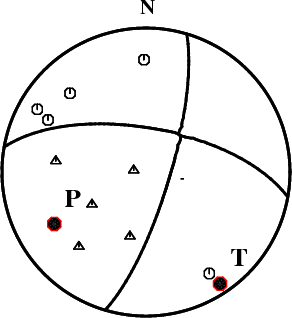
|
Waveform Inversion
The focal mechanism was determined using broadband seismic waveforms. The location of the event and the
and stations used for the waveform inversion are shown in the next figure.
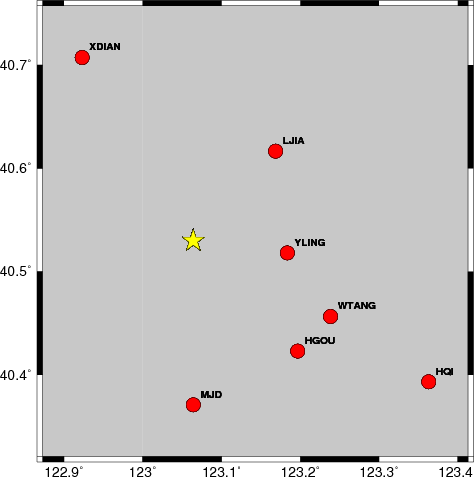
|
|
Location of broadband stations used for waveform inversion
|
The program wvfgrd96 was used with good traces observed at short distance to determine the focal mechanism, depth and seismic moment. This technique requires a high quality signal and well determined velocity model for the Green functions. To the extent that these are the quality data, this type of mechanism should be preferred over the radiation pattern technique which requires the separate step of defining the pressure and tension quadrants and the correct strike.
The observed and predicted traces are filtered using the following gsac commands:
hp c 0.05 n 3
lp c 0.50 n 3
The results of this grid search from 0.5 to 19 km depth are as follow:
DEPTH STK DIP RAKE MW FIT
WVFGRD96 0.5 10 90 -20 3.46 0.4556
WVFGRD96 1.0 275 65 -30 3.55 0.4849
WVFGRD96 2.0 105 75 20 3.58 0.5152
WVFGRD96 3.0 280 75 -15 3.63 0.5286
WVFGRD96 4.0 280 75 -15 3.67 0.5405
WVFGRD96 5.0 280 70 -15 3.70 0.5662
WVFGRD96 6.0 280 70 -20 3.73 0.5904
WVFGRD96 7.0 275 65 -25 3.76 0.6185
WVFGRD96 8.0 275 70 -25 3.78 0.6272
WVFGRD96 9.0 275 70 -25 3.80 0.6166
WVFGRD96 10.0 275 70 -30 3.81 0.5943
WVFGRD96 11.0 275 70 -30 3.83 0.5794
WVFGRD96 12.0 280 80 -20 3.84 0.5562
WVFGRD96 13.0 280 80 -20 3.85 0.5399
WVFGRD96 14.0 280 80 -15 3.86 0.5309
WVFGRD96 15.0 280 80 -15 3.87 0.4979
WVFGRD96 16.0 105 90 10 3.89 0.5119
WVFGRD96 17.0 105 90 10 3.90 0.5140
WVFGRD96 18.0 285 90 -10 3.91 0.5023
WVFGRD96 19.0 285 90 -10 3.93 0.5203
WVFGRD96 20.0 105 90 15 3.94 0.5239
WVFGRD96 21.0 105 90 10 3.97 0.5239
WVFGRD96 22.0 105 90 15 3.96 0.5052
WVFGRD96 23.0 285 90 -10 3.99 0.5117
WVFGRD96 24.0 105 85 15 4.00 0.5182
WVFGRD96 25.0 105 90 10 4.02 0.5196
WVFGRD96 26.0 105 90 10 4.03 0.5135
WVFGRD96 27.0 105 75 25 4.02 0.4937
WVFGRD96 28.0 105 75 25 4.03 0.4962
WVFGRD96 29.0 105 75 20 4.05 0.4957
The best solution is
WVFGRD96 8.0 275 70 -25 3.78 0.6272
The mechanism correspond to the best fit is
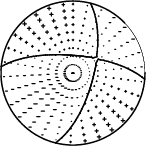
|
|
Figure 1. Waveform inversion focal mechanism
|
The best fit as a function of depth is given in the following figure:

|
|
Figure 2. Depth sensitivity for waveform mechanism
|
The comparison of the observed and predicted waveforms is given in the next figure. The red traces are the observed and the blue are the predicted.
Each observed-predicted componnet is plotted to the same scale and peak amplitudes are indicated by the numbers to the left of each trace. The number in black at the rightr of each predicted traces it the time shift required for maximum correlation between the observed and predicted traces. This time shift is required because the synthetics are not computed at exactly the same distance as the observed and because the velocity model used in the predictions may not be perfect.
A positive time shift indicates that the prediction is too fast and should be delayed to match the observed trace (shift to the right in this figure). A negative value indicates that the prediction is too slow.
The bandpass filter used in the processing and for the display was
hp c 0.05 n 3
lp c 0.50 n 3
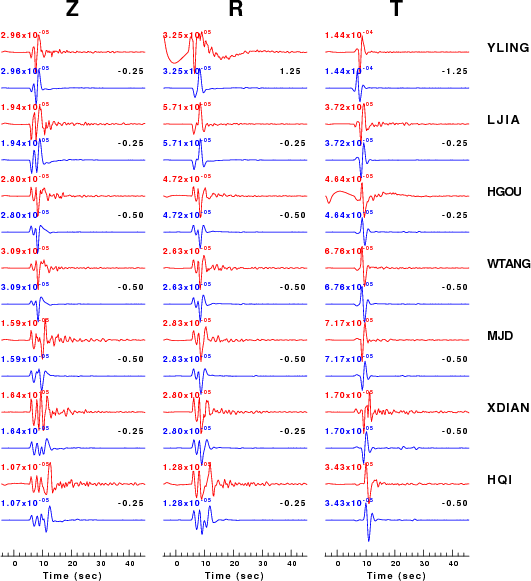
|
|
Figure 3. Waveform comparison for selected depth
|
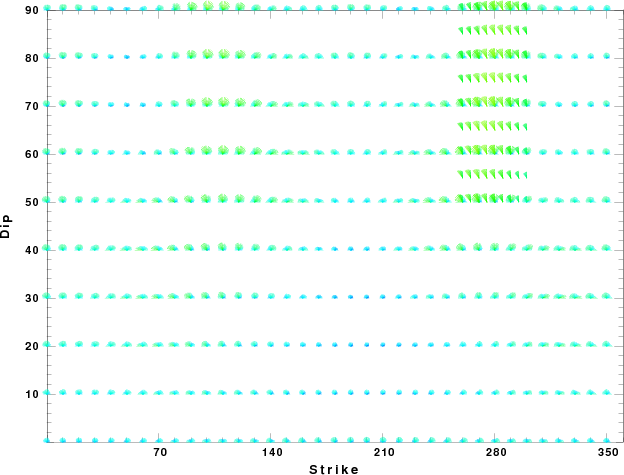
|
|
Focal mechanism sensitivity at the preferred depth. The red color indicates a very good fit to thewavefroms.
Each solution is plotted as a vector at a given value of strike and dip with the angle of the vector representing the rake angle, measured, with respect to the upward vertical (N) in the figure.
|
Discussion
The Future
Should the national backbone of the
USGS Advanced National Seismic System (ANSS)
be implemented with an interstation separation of 300 km, it is very likely that
an earthquake such as this would have been recorded at distances on the order of
100-200 km. This means that the closest station would have information on
source depth and mechanism that was lacking here.
Acknowledgements
Dr. Harley Benz, USGS, provided the USGS USNSN digital data.
The digital data used in this study were provided by Natural Resources Canada through their AUTODRM site http://www.seismo.nrcan.gc.ca/nwfa/autodrm/autodrm_req_e.php, and IRIS using their BUD interface.
Thanks also to the many seismic network operators whose dedication make this effort possible: University of Alaska, University of Washington, Oregon State University, University of Utah, Montana Bureas of Mines, UC Berkely, Caltech, UC San Diego, Saint L ouis University, Universityof Memphis, Lamont Doehrty Earth Observatory, Boston College, the Iris stations and the Transportable Array of EarthScope.
Velocity Model
The CUS used for the waveform synthetic seismograms and for the surface wave eigenfunctions and dispersion is as follows:
MODEL.01
CUS Model with Q from simple gamma values
ISOTROPIC
KGS
FLAT EARTH
1-D
CONSTANT VELOCITY
LINE08
LINE09
LINE10
LINE11
H(KM) VP(KM/S) VS(KM/S) RHO(GM/CC) QP QS ETAP ETAS FREFP FREFS
1.0000 5.0000 2.8900 2.5000 0.172E-02 0.387E-02 0.00 0.00 1.00 1.00
9.0000 6.1000 3.5200 2.7300 0.160E-02 0.363E-02 0.00 0.00 1.00 1.00
10.0000 6.4000 3.7000 2.8200 0.149E-02 0.336E-02 0.00 0.00 1.00 1.00
20.0000 6.7000 3.8700 2.9020 0.000E-04 0.000E-04 0.00 0.00 1.00 1.00
0.0000 8.1500 4.7000 3.3640 0.194E-02 0.431E-02 0.00 0.00 1.00 1.00
Quality Control
Here we tabulate the reasons for not using certain digital data sets
The following stations did not have a valid response files:
DATE=Thu May 20 22:53:47 CDT 2010
Last Changed 2007/08/24





